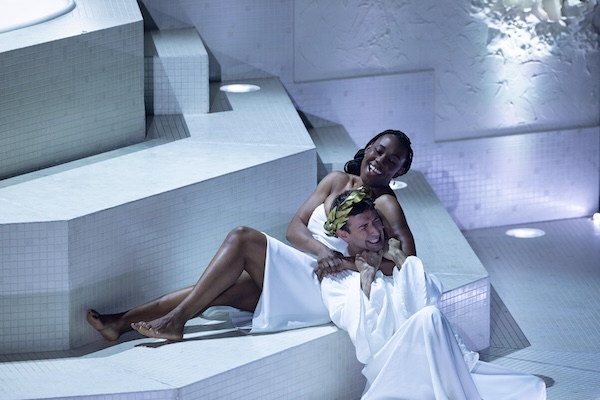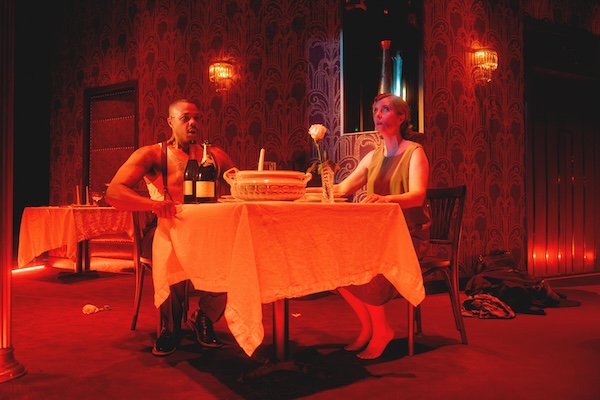Opera worlds collide and a few survive at Lincoln Center

The big event at Lincoln Center this summer is the Run Amoc* festival, produced by the American Modern Opera Company. More than opera, the festival will cover instrumental performances and dance events, along with music theater.
But opera was the headlining event for the festival’s opening night Wednesday, with the New York premiere of The Comet / Poppea.
The Comet / Poppea is two operas set side by side, literally so in this staging by Yuval Sharon in the David H. Koch Theater. The Comet is George Lewis’ setting of a W.E. Du Bois story about the tail of a comet passing over Manhattan, seemingly killing everyone except for a black man and a white woman. Poppea is Monteverdi’s L’Incoronazione di Poppea, broken up into several individual scenes.
The presentation is compact in duration at about 90 minutes and scale. Everything takes place on a rotating platform on the stage, with the audience seated onstage on each side.
This is an unlikely and imaginative concept that often works brilliantly in execution. Yet it also has some serious flaws that are inherent in its design, and was both supported and undermined by Sharon’s staging.
Musically, this is a compelling work. Monteverdi’s score is a great work, full of beautiful and emotionally complex music. It’s a daunting task to combine new music with one of the historical masters, and Lewis not only meets but exceeds the challenge. The two scores are fully combined, sometimes with jump-cut like immediate juxtapositions, often with The Comet worming its way from the inside until it overtakes Poppea.
Likewise, the terrific casts are mostly separate but do interact in a few ways. On The Comet side (one half of the platform), Jim is sung by the excellent bass-baritone Davóne Tines and Julia by soprano Kiera Duffy. In Poppea, the title character is soprano Kearstin Piper Brown, and Nero is countertenor Anthony Roth Costanzo (he also steps over for a small role as Julia’s father in The Comet). Seneca is bass Evan Hughs, mezzo-soprano Amanda Lynn Bottoms sings Ottone and Virtue, soprano Whitney Morrison is Ottavia and Fortune, and soprano Joelle Lamarre is Love.
The combination starts with the music from Poppea—though action is constant on both sides of the set—and the singing was impressive from the start. Bottoms in particular had a scintillating timbre, with the strength and grain of fine wood, and the blend among her and the sopranos, and later with Costanzo was a pleasure to hear. Costanzo’s color and force boosted the vibrancy of every scene he was in.
On The Comet side, both Tines and Duffy were deeply sympathetic and expressive, two humane and compelling performances. The Comet was consistently satisfying, with the most vocally skillful and characterful writing one has heard from Lewis. The mix of two musics makes this a polystylistic experience, which Lewis himself furthers by bringing hints of jazz, hymns, and even Salvatore Sciarrino into his classic post-serial modernistic language. In an exciting way, Lewis sounds like he’s channeling Charles Ives and Alfred Schnittke while still being his own man.
The built-in flaw is that Poppea and The Comet are at two different and incompatible scales. The story of The Comet comes through completely, but there are only isolated moments of Poppea, highlighting some of the eroticism, Seneca’s suicide, and the haunting love duet between Poppea and Nero, “Pur ti miro, pur ti godo.” Even as that is a moving musical stretch in the production, the Poppea drama just doesn’t come through.
Nor does there always seem a good reason the two are even placed together. Opening with Virtue, Fortune, and Love setting the frame works in parallel with The Comet, and there’s a sad irony in “Pur ti miro, pur ti godo,” but the jealousy and political intrigues of Poppea have noting to do with The Comet, which is upfront about its own ironic possibilities of catastrophe being the thing that overcomes racial and social divisions—which in the end remain. Even as the notes move elegantly between pieces, the drama just as often collides or splits.
The extended stretch of climax and finale are engrossing and moving, but they have to overcome what feels like a serious compositional mistake, the singing replaced by an extended spoken word stretch. This dispels the magic that was building and is frustrating to sit through, but when the singing returns for the finale, the work reaches its heights.
As well designed and made as the sets and costumes are, there were two major technical problems Wednesday. The first seemed accidental, a malfunction in the turntable that halted the stage’s turning for a stretch during the finale.
The other was the sound design from the usually reliable Mark Grey. With the rotating stage and the orchestra (a mix of early and modern instruments conducted by Marc Lowenstein) in the back, singers and instruments are miked, and this was poorly done. The amplified sound of the voices was flat and thin and clashed with their natural timbres, spoiling a lot of articulation. The instruments had no resonance and sounded brittle and distant. One’s ears did adapt, and heard more clearly, but that didn’t mean the sound improved.
Ultimately, even as from moment to moment this can be stimulating and captivating, there’s an ambiguity at the core of this production that is not only never resolved, but doesn’t seem apparent to the producers. These are two conventional narratives shoved together. The Comet is clear as can be, and can stand alone as a skillful and effective chamber opera. Poppea is incomplete by design, but it’s still an established genre piece within the operatic tradition.
There’s a strong impression that the producers are satisfied with the combination of the two, that they reveal truths about each other and the opera world, and consider this avant-garde. What this production really shows is that in inching toward an idea of truly avant-garde and experimental opera, they still have miles to go.
The Comet / Poppea runs through June 21. The Run Amoc* Festival continues through July 16. LincolnCenter.org/RunAMOC

